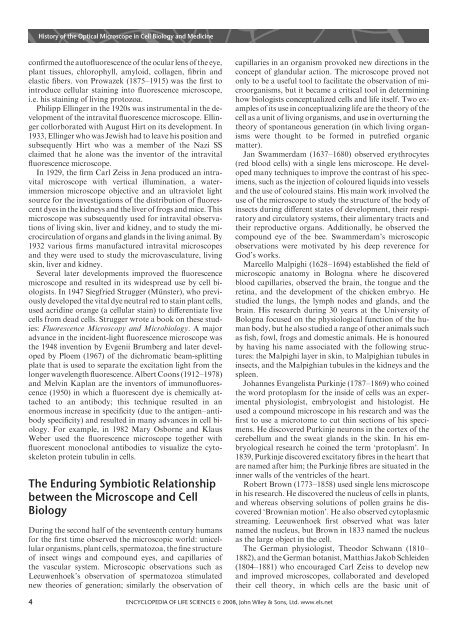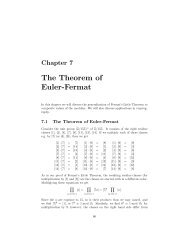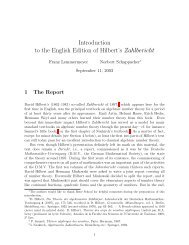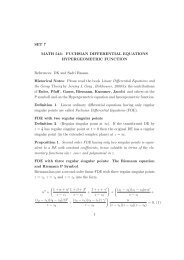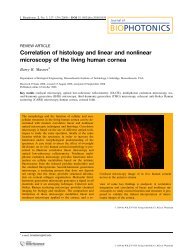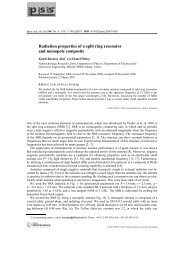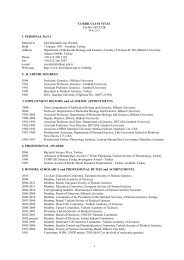History of the Optical Microscope in Cell Biology and Medicine
History of the Optical Microscope in Cell Biology and Medicine
History of the Optical Microscope in Cell Biology and Medicine
Create successful ePaper yourself
Turn your PDF publications into a flip-book with our unique Google optimized e-Paper software.
confirmed <strong>the</strong> aut<strong>of</strong>luorescence <strong>of</strong> <strong>the</strong> ocular lens <strong>of</strong> <strong>the</strong> eye,<br />
plant tissues, chlorophyll, amyloid, collagen, fibr<strong>in</strong> <strong>and</strong><br />
elastic fibers. von Prowazek (1875–1915) was <strong>the</strong> first to<br />
<strong>in</strong>troduce cellular sta<strong>in</strong><strong>in</strong>g <strong>in</strong>to fluorescence microscope,<br />
i.e. his sta<strong>in</strong><strong>in</strong>g <strong>of</strong> liv<strong>in</strong>g protozoa.<br />
Philipp Ell<strong>in</strong>ger <strong>in</strong> <strong>the</strong> 1920s was <strong>in</strong>strumental <strong>in</strong> <strong>the</strong> development<br />
<strong>of</strong> <strong>the</strong> <strong>in</strong>travital fluorescence microscope. Ell<strong>in</strong>ger<br />
collorborated with August Hirt on its development. In<br />
1933, Ell<strong>in</strong>ger who was Jewish had to leave his position <strong>and</strong><br />
subsequently Hirt who was a member <strong>of</strong> <strong>the</strong> Nazi SS<br />
claimed that he alone was <strong>the</strong> <strong>in</strong>ventor <strong>of</strong> <strong>the</strong> <strong>in</strong>travital<br />
fluorescence microscope.<br />
In 1929, <strong>the</strong> firm Carl Zeiss <strong>in</strong> Jena produced an <strong>in</strong>travital<br />
microscope with vertical illum<strong>in</strong>ation, a waterimmersion<br />
microscope objective <strong>and</strong> an ultraviolet light<br />
source for <strong>the</strong> <strong>in</strong>vestigations <strong>of</strong> <strong>the</strong> distribution <strong>of</strong> fluorescent<br />
dyes <strong>in</strong> <strong>the</strong> kidneys <strong>and</strong> <strong>the</strong> liver <strong>of</strong> frogs <strong>and</strong> mice. This<br />
microscope was subsequently used for <strong>in</strong>travital observations<br />
<strong>of</strong> liv<strong>in</strong>g sk<strong>in</strong>, liver <strong>and</strong> kidney, <strong>and</strong> to study <strong>the</strong> microcirculation<br />
<strong>of</strong> organs <strong>and</strong> gl<strong>and</strong>s <strong>in</strong> <strong>the</strong> liv<strong>in</strong>g animal. By<br />
1932 various firms manufactured <strong>in</strong>travital microscopes<br />
<strong>and</strong> <strong>the</strong>y were used to study <strong>the</strong> microvasculature, liv<strong>in</strong>g<br />
sk<strong>in</strong>, liver <strong>and</strong> kidney.<br />
Several later developments improved <strong>the</strong> fluorescence<br />
microscope <strong>and</strong> resulted <strong>in</strong> its widespread use by cell biologists.<br />
In 1947 Siegfried Strugger (Mu¨nster), who previously<br />
developed <strong>the</strong> vital dye neutral red to sta<strong>in</strong> plant cells,<br />
used acrid<strong>in</strong>e orange (a cellular sta<strong>in</strong>) to differentiate live<br />
cells from dead cells. Strugger wrote a book on <strong>the</strong>se studies:<br />
Fluorescence Microscopy <strong>and</strong> Microbiology. A major<br />
advance <strong>in</strong> <strong>the</strong> <strong>in</strong>cident-light fluorescence microscope was<br />
<strong>the</strong> 1948 <strong>in</strong>vention by Evgenii Brumberg <strong>and</strong> later developed<br />
by Ploem (1967) <strong>of</strong> <strong>the</strong> dichromatic beam-splitt<strong>in</strong>g<br />
plate that is used to separate <strong>the</strong> excitation light from <strong>the</strong><br />
longer wavelength fluorescence. Albert Coons (1912–1978)<br />
<strong>and</strong> Melv<strong>in</strong> Kaplan are <strong>the</strong> <strong>in</strong>ventors <strong>of</strong> immun<strong>of</strong>luorescence<br />
(1950) <strong>in</strong> which a fluorescent dye is chemically attached<br />
to an antibody; this technique resulted <strong>in</strong> an<br />
enormous <strong>in</strong>crease <strong>in</strong> specificity (due to <strong>the</strong> antigen–antibody<br />
specificity) <strong>and</strong> resulted <strong>in</strong> many advances <strong>in</strong> cell biology.<br />
For example, <strong>in</strong> 1982 Mary Osborne <strong>and</strong> Klaus<br />
Weber used <strong>the</strong> fluorescence microscope toge<strong>the</strong>r with<br />
fluorescent monoclonal antibodies to visualize <strong>the</strong> cytoskeleton<br />
prote<strong>in</strong> tubul<strong>in</strong> <strong>in</strong> cells.<br />
The Endur<strong>in</strong>g Symbiotic Relationship<br />
between <strong>the</strong> <strong>Microscope</strong> <strong>and</strong> <strong>Cell</strong><br />
<strong>Biology</strong><br />
Dur<strong>in</strong>g <strong>the</strong> second half <strong>of</strong> <strong>the</strong> seventeenth century humans<br />
for <strong>the</strong> first time observed <strong>the</strong> microscopic world: unicellular<br />
organisms, plant cells, spermatozoa, <strong>the</strong> f<strong>in</strong>e structure<br />
<strong>of</strong> <strong>in</strong>sect w<strong>in</strong>gs <strong>and</strong> compound eyes, <strong>and</strong> capillaries <strong>of</strong><br />
<strong>the</strong> vascular system. Microscopic observations such as<br />
Leeuwenhoek’s observation <strong>of</strong> spermatozoa stimulated<br />
new <strong>the</strong>ories <strong>of</strong> generation; similarly <strong>the</strong> observation <strong>of</strong><br />
4<br />
<strong>History</strong> <strong>of</strong> <strong>the</strong> <strong>Optical</strong> <strong>Microscope</strong> <strong>in</strong> <strong>Cell</strong> <strong>Biology</strong> <strong>and</strong> Medic<strong>in</strong>e<br />
capillaries <strong>in</strong> an organism provoked new directions <strong>in</strong> <strong>the</strong><br />
concept <strong>of</strong> gl<strong>and</strong>ular action. The microscope proved not<br />
only to be a useful tool to facilitate <strong>the</strong> observation <strong>of</strong> microorganisms,<br />
but it became a critical tool <strong>in</strong> determ<strong>in</strong><strong>in</strong>g<br />
how biologists conceptualized cells <strong>and</strong> life itself. Two examples<br />
<strong>of</strong> its use <strong>in</strong> conceptualiz<strong>in</strong>g life are <strong>the</strong> <strong>the</strong>ory <strong>of</strong> <strong>the</strong><br />
cell as a unit <strong>of</strong> liv<strong>in</strong>g organisms, <strong>and</strong> use <strong>in</strong> overturn<strong>in</strong>g <strong>the</strong><br />
<strong>the</strong>ory <strong>of</strong> spontaneous generation (<strong>in</strong> which liv<strong>in</strong>g organisms<br />
were thought to be formed <strong>in</strong> putrefied organic<br />
matter).<br />
Jan Swammerdam (1637–1680) observed erythrocytes<br />
(red blood cells) with a s<strong>in</strong>gle lens microscope. He developed<br />
many techniques to improve <strong>the</strong> contrast <strong>of</strong> his specimens,<br />
such as <strong>the</strong> <strong>in</strong>jection <strong>of</strong> coloured liquids <strong>in</strong>to vessels<br />
<strong>and</strong> <strong>the</strong> use <strong>of</strong> coloured sta<strong>in</strong>s. His ma<strong>in</strong> work <strong>in</strong>volved <strong>the</strong><br />
use <strong>of</strong> <strong>the</strong> microscope to study <strong>the</strong> structure <strong>of</strong> <strong>the</strong> body <strong>of</strong><br />
<strong>in</strong>sects dur<strong>in</strong>g different states <strong>of</strong> development, <strong>the</strong>ir respiratory<br />
<strong>and</strong> circulatory systems, <strong>the</strong>ir alimentary tracts <strong>and</strong><br />
<strong>the</strong>ir reproductive organs. Additionally, he observed <strong>the</strong><br />
compound eye <strong>of</strong> <strong>the</strong> bee. Swammerdam’s microscopic<br />
observations were motivated by his deep reverence for<br />
God’s works.<br />
Marcello Malpighi (1628–1694) established <strong>the</strong> field <strong>of</strong><br />
microscopic anatomy <strong>in</strong> Bologna where he discovered<br />
blood capillaries, observed <strong>the</strong> bra<strong>in</strong>, <strong>the</strong> tongue <strong>and</strong> <strong>the</strong><br />
ret<strong>in</strong>a, <strong>and</strong> <strong>the</strong> development <strong>of</strong> <strong>the</strong> chicken embryo. He<br />
studied <strong>the</strong> lungs, <strong>the</strong> lymph nodes <strong>and</strong> gl<strong>and</strong>s, <strong>and</strong> <strong>the</strong><br />
bra<strong>in</strong>. His research dur<strong>in</strong>g 30 years at <strong>the</strong> University <strong>of</strong><br />
Bologna focused on <strong>the</strong> physiological function <strong>of</strong> <strong>the</strong> human<br />
body, but he also studied a range <strong>of</strong> o<strong>the</strong>r animals such<br />
as fish, fowl, frogs <strong>and</strong> domestic animals. He is honoured<br />
by hav<strong>in</strong>g his name associated with <strong>the</strong> follow<strong>in</strong>g structures:<br />
<strong>the</strong> Malpighi layer <strong>in</strong> sk<strong>in</strong>, to Malpighian tubules <strong>in</strong><br />
<strong>in</strong>sects, <strong>and</strong> <strong>the</strong> Malpighian tubules <strong>in</strong> <strong>the</strong> kidneys <strong>and</strong> <strong>the</strong><br />
spleen.<br />
Johannes Evangelista Purk<strong>in</strong>je (1787–1869) who co<strong>in</strong>ed<br />
<strong>the</strong> word protoplasm for <strong>the</strong> <strong>in</strong>side <strong>of</strong> cells was an experimental<br />
physiologist, embryologist <strong>and</strong> histologist. He<br />
used a compound microscope <strong>in</strong> his research <strong>and</strong> was <strong>the</strong><br />
first to use a microtome to cut th<strong>in</strong> sections <strong>of</strong> his specimens.<br />
He discovered Purk<strong>in</strong>je neurons <strong>in</strong> <strong>the</strong> cortex <strong>of</strong> <strong>the</strong><br />
cerebellum <strong>and</strong> <strong>the</strong> sweat gl<strong>and</strong>s <strong>in</strong> <strong>the</strong> sk<strong>in</strong>. In his embryological<br />
research he co<strong>in</strong>ed <strong>the</strong> term ‘protoplasm’. In<br />
1839, Purk<strong>in</strong>je discovered excitatory fibres <strong>in</strong> <strong>the</strong> heart that<br />
are named after him; <strong>the</strong> Purk<strong>in</strong>je fibres are situated <strong>in</strong> <strong>the</strong><br />
<strong>in</strong>ner walls <strong>of</strong> <strong>the</strong> ventricles <strong>of</strong> <strong>the</strong> heart.<br />
Robert Brown (1773–1858) used s<strong>in</strong>gle lens microscope<br />
<strong>in</strong> his research. He discovered <strong>the</strong> nucleus <strong>of</strong> cells <strong>in</strong> plants,<br />
<strong>and</strong> whereas observ<strong>in</strong>g solutions <strong>of</strong> pollen gra<strong>in</strong>s he discovered<br />
‘Brownian motion’. He also observed cytoplasmic<br />
stream<strong>in</strong>g. Leeuwenhoek first observed what was later<br />
named <strong>the</strong> nucleus, but Brown <strong>in</strong> 1833 named <strong>the</strong> nucleus<br />
as <strong>the</strong> large object <strong>in</strong> <strong>the</strong> cell.<br />
The German physiologist, Theodor Schwann (1810–<br />
1882), <strong>and</strong> <strong>the</strong> German botanist, Matthias Jakob Schleiden<br />
(1804–1881) who encouraged Carl Zeiss to develop new<br />
<strong>and</strong> improved microscopes, collaborated <strong>and</strong> developed<br />
<strong>the</strong>ir cell <strong>the</strong>ory, <strong>in</strong> which cells are <strong>the</strong> basic unit <strong>of</strong><br />
ENCYCLOPEDIA OF LIFE SCIENCES & 2008, John Wiley & Sons, Ltd. www.els.net


